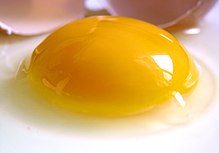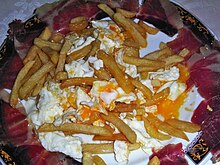Egg (food)
Eggs are a common food in the human diet. They are presented protected by a shell and are rich in protein (mainly albumin, which is the white or white part of the egg) and lipids. They are an easily digestible food, the main component of multiple sweet and savory dishes, and an essential part in many others due to its binding property.
Features
The most consumed, by far, are chicken (Gallus gallus domesticus), followed by duck and goose; Quail eggs are also consumed, which are very small, either as a gastronomic delicacy or for small children. Ostrich and rhea eggs are also edible and can weigh up to 1.3 kg. Almost all of them come from industrial exploitation: poultry farming. The eggs used for human consumption are as a general rule and the vast majority are unfertilized (with the exception of the Indonesian balut). Roe (like caviar) are fish eggs and are also edible in many cases by various cultures. The products obtained from the egg are called ovoproducts. In Mexico, since the Aztecs and even today, the mosquito's roe is consumed, which the females place in the lower parts of lagoons such as Lake Texcoco and call it ahuautle, known as Mexican caviar.
The eggs of reptiles such as iguanas and turtles (both marine and terrestrial) are also edible.
Regarding the freshness of an egg intended for human consumption in certain countries, such as the member states of the European Union, it is considered with the denomination of 'fresh eggs' those eggs that are intended for consumption within a period of 4 weeks from the laying of the hen. The denomination 'extra fresh' limit this period to just one week.
Chicken egg
Composition and nutrients
| Egg whole Approximate values (in weight) breed and bird type, as well as feeding | |
|---|---|
| Cascara | 10.5 % |
| Yema | 31 % |
| Clara | 58.5 % |
| Composition (per 100 grams) | Proteins | Lipids | Water | Minerals |
|---|---|---|---|---|
| Clara | 17.0 | 0.2 | 88.0 | 0.8 |
| Yema | 12 | 32.5 | 48,0 | 2.0 |
| Cascara | 3.3 | 1.6 | 96.0 |
| For every 60 grams (medium egg) | Proteins | Lipids | Water | Minerals |
|---|---|---|---|---|
| Clara | 10.2 | 0.12 | 58.2 | 0.5 |
| Yema | 6.3 | 19.5 | 28.8 | |
| Cascara | 2.0 | 1.0 | 57.6 |
The Shell
The shells of chicken eggs can be white or brown, which are actually light brown. Some hens lay eggs with a strong green-blue tinge. In different regions of the world they tend to prefer one over the other. In general, whites are associated with greater hygiene and browns with more naturalness, but in reality they are the same and have the same organoleptic properties. The eggshell is porous and can have 7,000 to 17,000 pores.
It is a great source of calcium, but –obviously– although it is edible, its consumption requires complex methods that allow it to be ingested without the risk of gastro-intestinal injuries. An example of shell ingestion is found in pickled eggs, where vinegar (acidic pH) softens the shell during preservation. Another possibility is to subject the peel to the action of citric acid (lemon juice) for a few hours; the resulting milky liquid can be ingested, resulting in an important source of replacement calcium in deficiency diseases such as osteomalacia and rickets and also in demineralization such as osteoporosis. Considering that the minimum dose is one gram per day, one shell provides approximately 6.5 grams of this mineral.
Biologically, the shell is a tertiary covering of the ovule, obtained (like the egg white) during its passage through the oviduct.
The Yolk
The yolk constitutes one third of the total weight of the egg and its biological function is to provide nutrients, calories, vitamin A, thiamine and iron necessary for the nutrition of the chicken that will grow inside it. The yellow color of the yolk does not come from beta-carotene (orange color of some vegetables) but from the xanthophylls that the hen obtains from alfalfa and various grains (such as corn). Keepers often pour asteraceae petals and other additives into the feed for laying hens that provide colour. Duck eggs show a deep orange color due to the canthaxanthin pigment that exists in aquatic insects and crustaceans in the diet of these birds.
The internal structure of the yolk is as if it were a set of concentric spheres (just like an onion). When the egg is cooked, these spheres coagulate into one. The yolk is protected and differentiated from the white by a vitelline membrane. In cooking, the egg yolk is usually used in the preparation of emulsified sauces based on egg yolks and fats (olive oil and/or butter). In some cases, they are already an ingredient in various pastry elements, such as Santa Clara egg yolks, chimbo eggs, Alcalá donuts and sky bacon.
Biologically, the yolk is an unfertilized ovum.
The white one
The white contributes two thirds of the total weight of the egg. It can be said that it is an almost transparent texture in whose composition almost 90% is water and the rest is protein, with traces of minerals, fatty materials, vitamins (riboflavin is what provides that slightly yellowish color) and glucose (glucose is responsible for darkening the egg in long-term conservation: centenary egg). The white proteins are present to defend the egg from infection by bacteria and other microorganisms, since its biological function is to stop biochemical aggressions from abroad.
The proteins included in the egg white are the following:
- Ovoalbumin is the most abundant in the egg (and it is the protein that was first crystallized in the laboratory in 1890). It is easily denaturalized with heat.
- Conalbumin makes 14 % of the total egg white proteins.
- The ovomucoid reaches a rate of 11 %. It is the cause of many of the answers allergic to the egg.
- Lisozima reaches 3.5 % and acts as an antibiotic.
- Avidine reaches a ratio of 0.05%. It binds to biotin and block.
- Flavoprotein 0.8 %, precursor of vitamins.
- Ovoinhibitor 1.5 %, main antiproteinous enzyme of the clear.
Egg white is a colloidal homogeneous mixture (solute between 1 and 100 nanometers). By virtue of being a colloid, it presents a very particular phenomenon of light scattering, called the Tyndall effect.
Size
White eggs and brown eggs only differ by the color of their shells, depending on the breed of the hen that laid them, since their nutritional content is the same. Chicken eggs can be of various sizes, being very small in young birds and large in adult birds. The difference is that, being larger, the shell is more fragile and prone to breaking. As a curiosity, these large eggs can come with a double yolk, due to a double ovulation of the bird.
The egg shell is made up mostly of calcium carbonate. It can be white or light chestnut (brown) in color, depending on the variety of the laying hen. The color of the shell does not affect its quality, flavor, cooking characteristics, nutritional value or thickness. An average chicken egg usually weighs between 60 and 70 grams
Types of chicken rearing and egg labeling
The eggs come from the so-called laying hens that can be raised in different ways and therefore the eggs will have a different category and label depending on the legislation and regulations of the different countries.
According to the European Production Model, eggs, which requires numbering each egg, can be:
- [0] - Eggs of green hens (ecological livestock, outdoor exit and more space),
- [1] - Eggs of pitcher hens (out of the open air, less space),
- [2] - Eggs of hens raised on the ground (in industrial ship but raised on the ground).
- [3] - Eggs of hens raised in cages (in industrial vessel, locked in cages).
Cooking use
Preparations - only egg
Eggs can be eaten plain in at least the following ways:
- Fried in various fatty media such as butter, olive oil or other vegetable oils suitable for human consumption, can also be fryed in animal oils (especially in butter).
- Iron in steel plates or anti-stick surfaces
- Tortillas, one of the most common preparations is the French tortilla in the West, the Spanish tortilla or potatoes or the Asian variant: tamagoyaki Japanese cuisine.
- Scrambled in which the yolk and the light clot together, sometimes results in broken eggs mixed with other foods
- Cooked with its skin for more than 10 minutes until its content becomes solid ('duros'), within this cocimiento are the so-called 'blandos' (cooked like the hard but with the soft yolk) and the by water (cooked with shell less than 5 minutes)
- Scalfados or pochados, cooked in broth or water (with vinegar or played lemon in the water to facilitate coagulation) without shell.
- To the dish or to the pot (cocotte) that are cooked in the oven and without its shell. Prepared in the oven usually lose 58% water per evaporation.
- Crude. In some cultures they eat raw.
- Dry or dehydrated eggs very typical preparation of Chinese gastronomy used mainly to make an egg conserve: Pidan (100-year-old egg).
- Salt in the Chinese kitchen are consumed duck eggs in salad.
- Fitted, vinegar or pickled eggs. In some cases the egg has been cooked previously and then subjected to an immersion in a vinegar solution with spices, in these cases you can eat with or without your skin.
- Fertilized in some culinary cultures of Asia eat the egg with a lock, i.e. fertilized by the rooster, an example is the balut of Indonesian.
- Bake as the eggs can be to the flamenca.
Preparations - egg as an ingredient
But eggs also form the basis of some basic culinary preparations due in part to their coagulation capacity, and thus we have potato omelettes and their innumerable variants with other vegetables: with asparagus, with leeks, with spinach, etc. In preparations such as the French omelette, sauces that contain eggs such as mayonnaise, sponge cake batter, soufflé, flans, pancakes or quiche, among many other dishes. It is used in the elaboration of certain pastas that are called 'al huevo' for having its egg mass as an ingredient. It can be found in cocktail preparations such as eggnog, or in liqueurs such as the Dutch advocaat (a kind of eggnog).
In confectionery, egg yolks are used mainly for the preparation of certain sweets and desserts due to their ability to combine masses, the so-called yolks (famous in Ávila, especially the Santa Teresa yolks), bacon from heaven, the whites for meringues and is used as an ingredient in sorbets, creams: the crème brûlée. Preparations with egg foam that are made by beating the whites until a foam is obtained that is part of soufflés, gin fizzes, mousses, etc.
Effects of some ingredients
Eggs are sometimes cooked with other ingredients that can range from common salt, lemon juice to sour cream, milk, brandy, etc. Egg proteins react differently with the addition of these elements. When egg is diluted with other liquids, as a general rule, the temperature at which it "curdles" is increased. the egg since dissolution causes the distances of the proteins to meet more water molecules and more temperature is necessary for the protein molecules to denature (and therefore set). Sugar raises the temperature equally. If we consider the mixture of a glass of milk, sugar and an egg, when not mixed, the curdling temperature is close to 70 °C while the mixture will be around 78 °C-80 °C.
Salt and acidic foods are often said to 'harden' the skin. egg proteins. This is because they lower the coagulation temperature, but at the same time produce a more tender texture (especially with the addition of acidic ingredients). In some recipes from the Middle Ages, verjus was used as an acidulant in egg preparations; In Moroccan cuisine there are scrambled egg dishes to which vinegar is added.
Nutritional value and influence on health
Eggs are a cheap and rich source of protein and in almost all their preparations they are very digestive. They are also rich in vitamins (although they lack vitamin C) and essential minerals (see attached table). There has been, however, some controversy about its cholesterol content, which is high. However, the egg yolk is also rich in phospholipids, especially phosphatidylcholine or lecithin, which by esterification and substitution would clean it (note the conditional) of the very risky bad cholesterol (LDL), although they also contain fatty acids and omega three, which eliminate cholesterol and, since these are present to a greater extent, the risk is not excessive. It is not an issue that is clear or settled, like so many others in nutrition. Many studies find no relationship between ingested cholesterol and blood cholesterol. The traditional consideration of not taking more than two eggs a day or more than ten a week has been questioned.
Eggs are convenient for pregnant women since they contain choline, which facilitates the development of the central nervous system of the embryo and fetus; likewise, the presence of choline transformed into acetylcholine helps memory in humans. The egg is also rich in lutein and zeaxanthin, which prevents eye problems such as cataracts.
Eggs, mainly because of the satiety they provide, are considered a good food to include in diets focused on losing body fat.
Avidin, a substance present in raw eggs, especially when bound to biotin, is highly resistant to proteolysis by enzymes in the human digestive tract, thus making the bound biotin totally unavailable. The ingestion of large amounts of raw egg white produces a vitamin deficiency.
Preservation and care
Eggs are the most common source of salmonellosis. The cause is usually in remains of chicken excrement that can remain attached to the shell if they come into contact with the interior and if they are eaten raw. There is less risk if you buy eggs that are sold at retail in grocery stores because companies wash them before they arrive at the grocery store.
They should be kept refrigerated: as a general rule, an egg will spoil at the same rate in one day if placed at room temperature as it does in the refrigerator for four days. Eggs can be frozen for several months. There is pasteurized liquid egg on the market. The authorities of each country usually make specific regulations on the labeling of eggs on the egg shells so that the consumer is informed about the state and origin of the egg they consume.
When you submerge a bad egg, it will float due to the accumulation of gases inside. Eggs in a good state of preservation will always remain at the bottom.
Contenido relacionado
Pulmonary embolism
Now
Atresia









